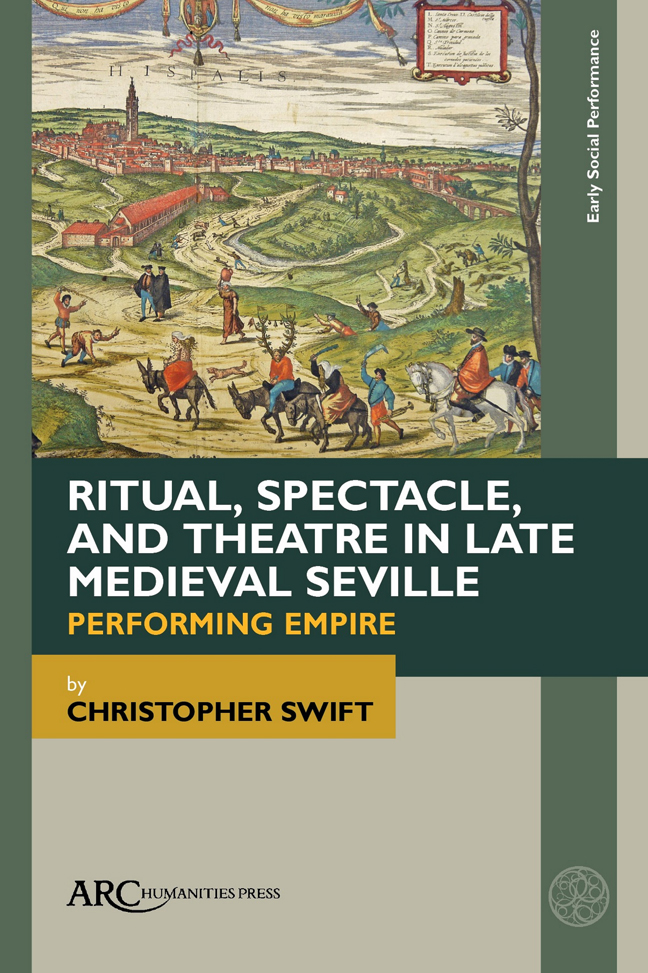Book contents
- Frontmatter
- Contents
- List of Illustrations
- Abbreviations
- Notes
- Acknowledgements
- Introduction. Theatres of Absence
- Chapter 1 The Cantigas de Santa Maria: Theatrical Acculturation of the Andalusi Colony
- Chapter 2 Penance, Conversion, and Affective Convivencia
- Chapter 3 Strange Infidels in the Imperial Metropole
- Conclusion. Walking Ghosts
- Bibliography
- Index
Conclusion. Walking Ghosts
Published online by Cambridge University Press: 22 February 2024
- Frontmatter
- Contents
- List of Illustrations
- Abbreviations
- Notes
- Acknowledgements
- Introduction. Theatres of Absence
- Chapter 1 The Cantigas de Santa Maria: Theatrical Acculturation of the Andalusi Colony
- Chapter 2 Penance, Conversion, and Affective Convivencia
- Chapter 3 Strange Infidels in the Imperial Metropole
- Conclusion. Walking Ghosts
- Bibliography
- Index
Summary
THEATRE HISTORIOGRAPHY IS an ambient poetics, a pursuit of transitory present- ness by way of transhistorical objects, “something material and physical, though somewhat intangible, as if space itself had a material aspect.” Essentially ephemeral, live performance is always already fleeing the present of its own past, a restless specter haunting stages and books across time. The history of medieval theatre is revealed in the stubbornly persistent objects of then and now, objects that also reveal new truths about contemporary reenactors. Questions are as pertinent as answers. Writing about a late-fifteenth-century Carthusian miscellany, Jessica Brantley speaks to the value of this impulse: “Though [the manuscript] engages the performative in a range of senses so wide that it might threaten to escape the bounds of any category, medieval or modern, all of its offerings reflect that fundamental ‘consciousness of consciousness.’” Medieval theatre is methodology and phenomenon.
In the illuminations, poetry, and music of the Cantigas de Santa Maria, the Mother of Jesus performed the role of spiritual mediator between Christian conquerors and vanquished Muslims. Various elements from Islamic poetry and musical culture were accentuated when the lyrics and melodies of the Cantigas rose from the parchment and manifested in theatrical space. Bodies, spaces, and voices of the Islamic past haunted the exaltations of the Cantigas, the narratives of which vacillated between depictions of Muslims as infidels and as people capable of Christian conversion. The songs were ambivalently situated at the juncture of competing discourses, the efficacy of which required the living presence and performative interventions of the Virgin Mary. From page to stage, the embodiment of miracles and songs of praise in Alfonso's guidebooks for Marian devotion did not represent a move toward erasure of difference, but rather to fashion a unique cultural centre in the Castilian realm.
From the fifteenth century, Christian anxieties about apostatic Jews were expressed fervently in performative acts of penance and punishment. On the one hand, Jewish presence was an “Other who had guaranteed the integrity of Christendom by marking its exteriority.” On the other hand, the spectral Jew produced deep doubts about genuine Christian transformation. As the Jewish presence in the city diminished, New Christians and Old took up practices of public penance, like imitatio Christi—acts of selfmortification that reanimated Christ's tortuous path to Golgotha.
- Type
- Chapter
- Information
- Ritual, Spectacle, and Theatre in Late Medieval SevillePerforming Empire, pp. 165 - 168Publisher: Amsterdam University PressPrint publication year: 2023



